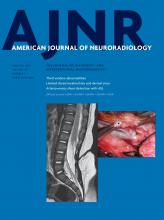Index by author
Gounis, M.J.
- EDITOR'S CHOICENeurointerventionOpen AccessEmergent Endovascular Management of Long-Segment and Flow-Limiting Carotid Artery Dissections in Acute Ischemic Stroke Intervention with Multiple Tandem StentsS.A. Ansari, A.L. Kühn, A.R. Honarmand, M. Khan, M.C. Hurley, M.B. Potts, B.S. Jahromi, A. Shaibani, M.J. Gounis, A.K. Wakhloo and A.S. PuriAmerican Journal of Neuroradiology January 2017, 38 (1) 97-104; DOI: https://doi.org/10.3174/ajnr.A4965
The authors investigated the role of emergent endovascular stenting of long-segment carotid dissections in the acute ischemic stroke setting in 15 patients. They specifically evaluated long-segment carotid dissections requiring stent reconstruction with multiple tandem stents (≥ 3 stents) and presenting with acute (<12 hours) ischemic stroke symptoms (NIHSS score, ≥ 4). Carotid stent reconstruction was successful in all patients with no residual stenosis or flow limitation. Nine patients (60%) harbored intracranial occlusions, and 6 patients (40%) required intra-arterial thrombolysis/thrombectomy, achieving 100% TICI 2b–3 reperfusion. They conclude that emergent stent reconstruction of long-segment and flow-limiting carotid dissections in acute ischemic stroke intervention is safe and effective, with favorable clinical outcomes.
Goyal, M.
- FELLOWS' JOURNAL CLUBNeurointerventionOpen AccessEndovascular Therapy of M2 Occlusion in IMS III: Role of M2 Segment Definition and Location on Clinical and Revascularization OutcomesT.A. Tomsick, J. Carrozzella, L. Foster, M.D. Hill, R. von Kummer, M. Goyal, A.M. Demchuk, P. Khatri, Y. Palesch, J.P. Broderick, S.D. Yeatts, D.S. Liebeskind and for the IMS III InvestigatorsAmerican Journal of Neuroradiology January 2017, 38 (1) 84-89; DOI: https://doi.org/10.3174/ajnr.A4979
The authors reviewed the impact of revascularization on clinical outcomes in 83 patients with M2 occlusions in the Interventional Management of Stroke III trial according to specific M1–M2 segment anatomic features. AnmRS 0–2 outcome was associated with reperfusion for M2 trunk (n = 9) or M2 division (n = 42) occlusions, but not for M2 branch occlusions (n = 28). Of the 83 participants with M2 occlusion who underwent endovascular therapy, 41.0% achieved mRS 0–2 at 90 days, including 46.6% with modified TICI 2–3 reperfusion compared with 26.1% with modified TICI 0–1 reperfusion. They conclude that mRS 0–2 at 90 days was dependent on reperfusion for M2 trunk but not for M2 branch occlusions in IMS III.
Guimaraens, L.
- NeurointerventionYou have accessEmbolization of Intracranial Dural Arteriovenous Fistulas Using PHIL Liquid Embolic Agent in 26 Patients: A Multicenter StudyS. Lamin, H.S. Chew, S. Chavda, A. Thomas, M. Piano, L. Quilici, G. Pero, M. Holtmannspolter, M.E. Cronqvist, A. Casasco, L. Guimaraens, L. Paul, A. Gil Garcia, A. Aleu and R. ChapotAmerican Journal of Neuroradiology January 2017, 38 (1) 127-131; DOI: https://doi.org/10.3174/ajnr.A5037
Guo, W.-Y.
- NeurointerventionYou have accessQuantifying the Cerebral Hemodynamics of Dural Arteriovenous Fistula in Transverse Sigmoid Sinus Complicated by Sinus Stenosis: A Retrospective Cohort StudyW.-Y. Guo, C.-C.J. Lee, C.-J. Lin, H.-C. Yang, H.-M. Wu, C.-C. Wu, W.-Y. Chung and K.-D. LiuAmerican Journal of Neuroradiology January 2017, 38 (1) 132-138; DOI: https://doi.org/10.3174/ajnr.A4960
Haller, S.
- Spine Imaging and Spine Image-Guided InterventionsYou have accessDynamic Contrast-Enhanced MR Perfusion of Intradural Spinal LesionsV. Cuvinciuc, M. Viallon, I. Barnaure, M.I. Vargas, K.-O. Lovblad and S. HallerAmerican Journal of Neuroradiology January 2017, 38 (1) 192-194; DOI: https://doi.org/10.3174/ajnr.A4995
- Adult BrainOpen AccessClinicoradiologic Correlations of Cerebral Microbleeds in Advanced AgeI. Barnaure, M.-L. Montandon, C. Rodriguez, F. Herrmann, K.O. Lövblad, P. Giannakopoulos and S. HallerAmerican Journal of Neuroradiology January 2017, 38 (1) 39-45; DOI: https://doi.org/10.3174/ajnr.A4956
Halpin, C.F.
- Head and Neck ImagingOpen AccessSpectrum of Third Window Abnormalities: Semicircular Canal Dehiscence and BeyondM.-L. Ho, G. Moonis, C.F. Halpin and H.D. CurtinAmerican Journal of Neuroradiology January 2017, 38 (1) 2-9; DOI: https://doi.org/10.3174/ajnr.A4922
Haussen, D.C.
- Adult BrainYou have accessBody Temperature Modulates Infarction Growth following Endovascular ReperfusionS. Dehkharghani, M. Bowen, D.C. Haussen, T. Gleason, A. Prater, Q. Cai, J. Kang and R.G. NogueiraAmerican Journal of Neuroradiology January 2017, 38 (1) 46-51; DOI: https://doi.org/10.3174/ajnr.A4969
Hernesniemi, J.
- NeurointerventionOpen AccessFlow Conditions in the Intracranial Aneurysm Lumen Are Associated with Inflammation and Degenerative Changes of the Aneurysm WallJ. Cebral, E. Ollikainen, B.J. Chung, F. Mut, V. Sippola, B.R. Jahromi, R. Tulamo, J. Hernesniemi, M. Niemelä, A. Robertson and J. FrösenAmerican Journal of Neuroradiology January 2017, 38 (1) 119-126; DOI: https://doi.org/10.3174/ajnr.A4951
Herrmann, F.
- Adult BrainOpen AccessClinicoradiologic Correlations of Cerebral Microbleeds in Advanced AgeI. Barnaure, M.-L. Montandon, C. Rodriguez, F. Herrmann, K.O. Lövblad, P. Giannakopoulos and S. HallerAmerican Journal of Neuroradiology January 2017, 38 (1) 39-45; DOI: https://doi.org/10.3174/ajnr.A4956
Hill, M.D.
- FELLOWS' JOURNAL CLUBNeurointerventionOpen AccessEndovascular Therapy of M2 Occlusion in IMS III: Role of M2 Segment Definition and Location on Clinical and Revascularization OutcomesT.A. Tomsick, J. Carrozzella, L. Foster, M.D. Hill, R. von Kummer, M. Goyal, A.M. Demchuk, P. Khatri, Y. Palesch, J.P. Broderick, S.D. Yeatts, D.S. Liebeskind and for the IMS III InvestigatorsAmerican Journal of Neuroradiology January 2017, 38 (1) 84-89; DOI: https://doi.org/10.3174/ajnr.A4979
The authors reviewed the impact of revascularization on clinical outcomes in 83 patients with M2 occlusions in the Interventional Management of Stroke III trial according to specific M1–M2 segment anatomic features. AnmRS 0–2 outcome was associated with reperfusion for M2 trunk (n = 9) or M2 division (n = 42) occlusions, but not for M2 branch occlusions (n = 28). Of the 83 participants with M2 occlusion who underwent endovascular therapy, 41.0% achieved mRS 0–2 at 90 days, including 46.6% with modified TICI 2–3 reperfusion compared with 26.1% with modified TICI 0–1 reperfusion. They conclude that mRS 0–2 at 90 days was dependent on reperfusion for M2 trunk but not for M2 branch occlusions in IMS III.








